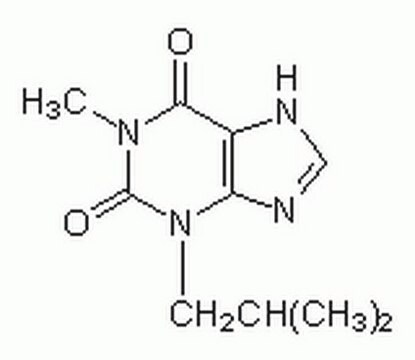DIF001
3T3-L1 DIFFERENTIATION KIT
Sufficient for 100 mL differentiation medium
Synonym(s):
3T3-L1 Differentiation Kit
Sign Into View Organizational & Contract Pricing
All Photos(1)
About This Item
UNSPSC Code:
12352207
NACRES:
NA.75
Recommended Products
form
solution
usage
100 mL differentiation medium
technique(s)
cell culture | mammalian: suitable
shipped in
wet ice
storage temp.
−20°C
General description
3T3-L1 cells are derived from mouse 3T3 cells and provide a widely-used fundamental model in the study of adipose physiology and metabolic diseases. They exhibit a fibroblast-like morphology before differentiation but become rounded and accumulate lipid droplets several days after the initiation of differentiation. The accumulated lipid droplets can be visualized by light microscopy. The in vitro differentiated 3T3-L1 adipocytes result in characteristics similar to tissue-derived adipocytes and have been commonly used to study adipogenesis, lipolysis, and metabolic dysfunctions. The 3T3-L1 Differentiation Kit provides enough supplements to make 100 ml of differentiation medium and 600 ml of maintenance medium which is sufficient material for 12 100 mm culture dishes.
Application
3T3-L1 DIFFERENTIATION KIT has been used in:
- Differentiation of 3T3-L1 preadipocytes to adipocytes.
- Study of obesity, adipogenesis, lipolysis and lipid metabolism
- Differentiation of 3T3-L1 preadipocytes to adipocytes
- Study of obesity, adipogenesis, lipolysis and lipid metabolism.
Components
Insulin (1.5 mg/ml) 0.6 ml (Catalog Number DIF001A, Green Cap)
Differentiation Cocktail, 1000x (lyophilized) 1 vl (Catalog Number DIF001B, Yellow Cap)
DMSO (anhydrous) 0.5 ml (Catalog Number DIF001C, Blue Cap)
Differentiation Cocktail, 1000x (lyophilized) 1 vl (Catalog Number DIF001B, Yellow Cap)
DMSO (anhydrous) 0.5 ml (Catalog Number DIF001C, Blue Cap)
Storage and Stability
Store the kit at −20 °C, protected from light.
signalword
Danger
hcodes
Hazard Classifications
Repr. 1B
Storage Class
6.1C - Combustible acute toxic Cat.3 / toxic compounds or compounds which causing chronic effects
Certificates of Analysis (COA)
Search for Certificates of Analysis (COA) by entering the products Lot/Batch Number. Lot and Batch Numbers can be found on a product’s label following the words ‘Lot’ or ‘Batch’.
Already Own This Product?
Find documentation for the products that you have recently purchased in the Document Library.
Jérémie Gautheron et al.
Nature communications, 7, 11869-11869 (2016-06-22)
Receptor-interacting protein kinase 3 (RIPK3) mediates necroptosis, a form of programmed cell death that promotes inflammation in various pathological conditions, suggesting that it might be a privileged pharmacological target. However, its function in glucose homeostasis and obesity has been unknown.
Fuu-Jen Tsai et al.
Frontiers in pharmacology, 9, 1004-1004 (2018-09-21)
Antiretroviral (ART) drugs has previously been associated with lipodystrophic syndrome, metabolic consequences, and neuropsychiatric complications. ART drugs include three main classes of protease inhibitors (PIs), nucleoside analog reverse transcriptase inhibitors (NRTIs), and non-nucleoside reverse transcriptase inhibitors (NNRTIs). Our previous work
Tamar Golan et al.
Science signaling, 12(591) (2019-07-25)
Transforming growth factor-β (TGF-β) superfamily members are critical signals in tissue homeostasis and pathogenesis. Melanoma grows in the epidermis and invades the dermis before metastasizing. This disease progression is accompanied by increased sensitivity to microenvironmental TGF-β. Here, we found that
Ke Song et al.
JCI insight, 5(21) (2020-10-02)
Chronic kidney disease (CKD) induces the failure of arteriovenous fistulas (AVFs) and promotes the differentiation of vascular adventitial GLI1-positive mesenchymal stem cells (GMCs). However, the roles of GMCs in forming neointima in AVFs remain unknown. GMCs isolated from CKD mice
Our team of scientists has experience in all areas of research including Life Science, Material Science, Chemical Synthesis, Chromatography, Analytical and many others.
Contact Technical Service







